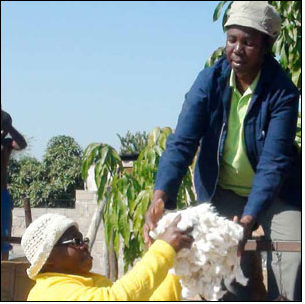Mpumalanga’s rural cotton farmers have overcome challenging conditions to produce good quality bales and create jobs.
 The farmers had to endure many hardships in 2013 but overcame these to meet the demands of their market, says Robert Nkalanga, chairman of the Nkomazi Secondary Cotton Cooperative.
The farmers had to endure many hardships in 2013 but overcame these to meet the demands of their market, says Robert Nkalanga, chairman of the Nkomazi Secondary Cotton Cooperative.
The cooperative, an umbrella body that comprises 16 cotton associations, including 525 farmers from the Nkomazi Local Municipality, congratulated farmers from Khombaso.
“Although they were operating on dry land and under dangerous conditions the farmers were still able to attain the best results,” said Nkalanga.
One of the challenges the farmers faced was poor pest control management, which was later addressed by workshops and training by the provincial Department of Agriculture, Rural Development and Land Administration.
Nkalanga said other farmers lost their cotton when a fire gutted their stores but they still managed to produce enough.
“As cotton farmers we were hoping that we would reach 4 000 cotton bales (last year) but we are happy with the more than 3 000 bales we produced in the face of all the challenges,” he said.
Cotton farmer Daisy Ngwenya, from Mangweni, was named highest cotton producer by cotton gin processing company Loskop Gin. Cotton gin is when the cotton fibre is removed from the seed.
Loskop Gin, which is in Marble Hall, Limpopo is the rural farmers’ biggest customer.
Ngwenya produced quality cotton that made 93 bales.
“I am very happy with the achievement. I managed to create 10 job opportunities for the locals who also played a big role in the success of my farm,” said the 59-year-old.
Her employees helped during soil preparation and harvesting.
Ngwenya started farming cotton in 2009 after she received a piece of land from a local chief. She started with a one hectare and managed to fill 1 000 basins of cotton.
“Most cotton farmers struggle a lot in their first year but I managed to nail it. I used that as a motivation to expand my farming land to five hectares. I am happy that I managed to control the American Bollworm pest, which gave most farmers a problem,” she said.
Ngwenya made more than R100 000 profit from 93 bales.
The department’s director in the Ehlanzeni district, Oneday Magagula, appreciated the cotton farmers’ high productivity.
“The future is looking bubbly for the farmers after putting up a great yield. We encourage them to establish cooperatives so that they can be able to take collective decisions,” said Magagula.
He added that the department would support the farmers in exploring the possibility of establishing a cotton mill and also with logistics. The farmers are supported with seeds, pesticides, tractors and training workshops to ensure that their businesses are sustainable.
Acting director in the department’s Masibuyele Emasimini programme Mandla Ndlala also applauded the farmers’ efforts.
“The R4.5 million the department injected to buy production inputs, chemicals, fertilisers and manure did not go into waste on cotton production because the cotton harvest has yielded great results,” said Ndlala.
The Masibuyele Emasimini programme was introduced in 2005 to encourage communities to take advantage of government’s agriculture-related projects. The project affords black farmers a realistic chance to improve production, increase yields and gain access to domestic and global markets.



 Facebook
Facebook Twitter
Twitter WhatsApp
WhatsApp